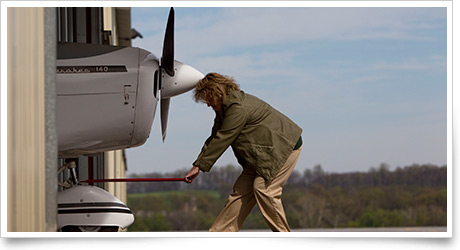Custom content for the Dec. 21, 2012, issue of 'AOPA ePilot' newsletter
| The following stories from the Dec. 21, 2012, edition of AOPA ePilot were provided to AOPA members who expressed an interest in the particular subject areas. Any AOPA member can receive information tailored to their areas of interest by updating their preferences online. |
training tipsDoing it yourself
Not quite the picture that usually greets you at the airport?
Many student pilots face more of a do-it-yourself proposition when it comes to preparing the trainer for flight. But that's not all bad. What may be lacking in service and amenities may give back as invaluable experience for possible future aircraft ownership. You will certainly come to appreciate the daily labors of airport line crews, and learn a thing or two about proper aircraft handling.
Winter “ramp ops” will also teach critical lessons about safety. Maneuvering an aircraft out of a parking spot or into a safe position for engine start requires thought and care, even more on an ice-crusted ramp. And any pilot who has fruitlessly fussed with frozen tiedown ropes, or tingled at the touch of a well-chilled towbar, will appreciate hearing the warning call “prop clear” from a nearby aircraft that is about to start.
Don’t struggle with a seriously stuck Skyhawk, or risk injury wrestling it into motion by yourself. Call for assistance—of the motorized variety if necessary. Never ignore placards warning against pushing or stepping on a control surface or other aircraft part.
Supervise motorized towing, making sure that the allowable nose-gear turning angle is not exceeded (in a 1980 Cessna 152 it is 30 degrees either side of center). Design of nosewheel steering mechanisms is what determines the limits; your trainer’s may differ.
Fueling the aircraft yourself? Attaching the grounding cable is an essential safety measure even if the line must be fished out of ice or snow. “It’s important to attach the cable to an unpainted surface to ensure good conductivity. Painted tiedown rings don’t count,” wrote Mark Twombly in the March 2009 Flight Training magazine’s “What It Looks Like” column.
Dress for success in the art of winter ground handling. If you have overlooked some important item, it’s not too late to ask Santa for that needed pair of warm gloves. training productsA VFR 12-month gift subscription to AOPA’s new FlyQ EFB makes a great stocking stuffer for the student pilot on your list. The AOPA member-only price is $69.99 for 12 months when purchased through AOPA. It includes seamless, georeferenced sectionals; more than 700 georeferenced FAA airport diagrams; smart auto-routing based on predicted winds aloft; 3-D synthetic vision; 3-D terrain; highway in the sky (HITS); and electronic flight instrument system (EFIS) display. It also features split screen view, track-up or north-up modes, the AOPA Airports directory information, covering more than 3,100 airport diagrams and AOPA member comments.
ASA’s Cockpit Procedures handbook is another great gift for the student pilot in your life. The handbook offers readers a solid understanding of the underlying principles for, and detailed descriptions of, the checklists and routines used in many flight schools. Users will find it contains a practical definition of airmanship, and covers good habits to develop, effective workload management, and even what you should have in your flight bag.
Note: Products listed have not been evaluated by ePilot editors unless otherwise noted. AOPA assumes no responsibility for products or services listed or for claims or actions by manufacturers or vendors. final examQuestion: What is a thermal plume and what kind of flight hazards exist around one?
Answer: A thermal plume is a vertically directed unstable gaseous emission from places such as power plants and industrial facilities. These high-temperature exhaust plumes can be visible or invisible and can cause significant atmospheric turbulence and vertical shear. They also can include other hazards such as reduced visibility, engine particulate contamination, and reduced oxygen levels. Aircraft damage can result from encountering such plumes. Pay particular attention to the charts especially in areas where low-level flight will be necessary, such as takeoff and landing, to avoid flying near or through a plume. The FAA is currently studying thermal plumes for potential changes to rules and policy regarding them.
Got a question for our technical services staff? Email [email protected] or call the Pilot Information Center, 800/872-2672. Don’t forget the online archive of “Final Exam” questions and answers, searchable by keyword or topic. |
 It's a calm sunny day, perfect for the important solo cross-country that you planned overnight. Your trainer has been towed from its sheltered spot in the warm hangar, and now sits on the ramp, wheels chocked, fuel tanks full. Soon you will preflight and launch on this milestone training flight.
It's a calm sunny day, perfect for the important solo cross-country that you planned overnight. Your trainer has been towed from its sheltered spot in the warm hangar, and now sits on the ramp, wheels chocked, fuel tanks full. Soon you will preflight and launch on this milestone training flight.

